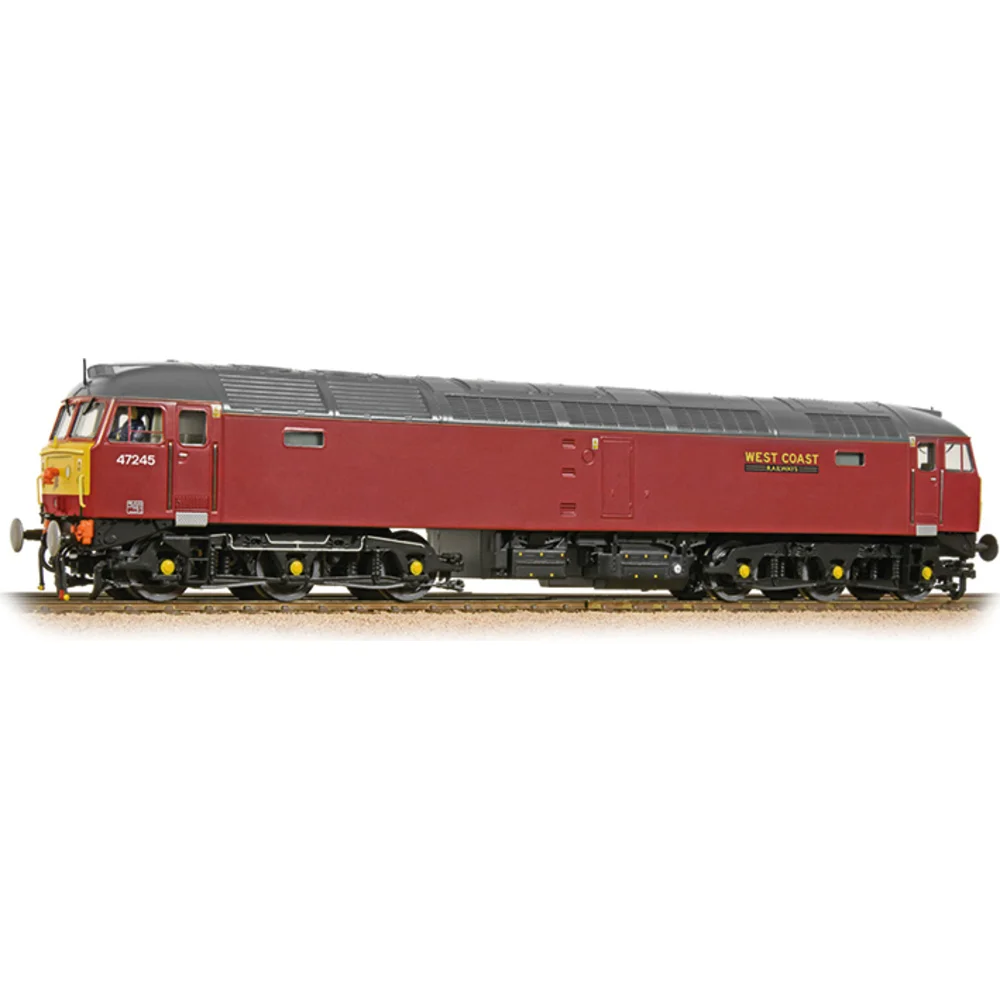Bachmann 32-818
British Rail Class 47/0 47245 West Coast Railways Maroon
Class & Prototype
- Class: British Rail Class 47/0
- Traction: Diesel
- Transmission: Electric
- Built: 1962-1965
- Total Built: -
The British Rail Class 47, or Brush Type 4, built 1962-1968, represents Britain's most numerous mainline diesel with 512 locomotives constructed by Brush Traction and BR Crewe Works. Despite early reliability problems, a mid-1960s decision to derate engines from 2,750 to 2,580 bhp transformed the class into Britain's most dependable mixed-traffic locomotive, achieving 55+ years service. Operating across all BR regions hauling everything from royal trains to coal hoppers, Class 47s wore over 30 distinct liveries spanning BR green through colourful sector schemes to privatisation colours. Currently, Bachmann and Heljan produce exceptional OO gauge models with motorised fans, ESU LokSound V5 sound, and 150+ detail parts, while Graham Farish dominates N gauge. With 32 preserved locomotives and continuing heritage operations, the "Duff" remains an iconic part of British railway heritage.
No prototype found.
Operator & Livery
- Operator: West Coast Railways
- Livery: Maroon
West Coast Railways is Britain's premier heritage railway operator and charter train company, operating from the historic Carnforth MPD in Lancashire since 1998. The company runs the world-famous Jacobite steam train through the Scottish Highlands from Fort William to Mallaig, crossing the iconic Glenfinnan viaduct featured in the Harry Potter films.
As a licensed train operating company and spot-hire operator, West Coast Railways provides steam and diesel locomotives, heritage carriages, and crews for charter services across the UK's most scenic routes. Their extensive fleet includes preserved Black Five locomotives, Royal Scot and Jubilee classes, plus heritage diesel traction including Class 37 and Class 57 machines.
The company also operates popular services including the Scarborough Spa Express and Dalesman tours over the spectacular Settle and Carlisle line. Based at the former LMS depot featured in the 1945 film Brief Encounter, West Coast Railways maintains comprehensive workshop facilities for steam locomotive restoration and heritage carriage maintenance.
Despite facing modern regulatory challenges, the company continues to provide authentic railway heritage experiences using preserved locomotives and period rolling stock, attracting both railway enthusiasts and international tourists to Britain's steam railway legacy.
West Coast Railways Standard Maroon Livery represents the company's primary locomotive scheme applied to their diverse diesel fleet since 1998. This distinctive livery features a maroon base colour with grey roof sections and the characteristic West Coast Railways gold logo prominently displayed on the locomotive bodysides.
The scheme has been applied across multiple locomotive classes including Class 31, Class 37, Class 47, and Class 57 machines, creating visual consistency throughout the WCR fleet. Notable examples include Class 37 locomotives 37516 Loch Laidon, 37518 Fort William/An Gearasdan, 37669, 37676 Loch Rannoch, 37685 Loch Arkaig, and 37706, plus Class 47 locomotives such as 47854, and Class 57 examples including 57313.
The livery maintains the West Coast Railways corporate identity established to complement their maroon coaching stock, creating cohesive train formations for charter services. The scheme uses a simplified two-tone approach with clean lines and minimal complications, ensuring easy maintenance whilst providing professional appearance standards required for mainline operations.
Class 31/1 locomotive 31190 Gryphon also carried this standard maroon scheme, demonstrating WCR's consistent application across their entire diesel fleet regardless of locomotive class or operational role.
For railway modellers, the Standard WCR Maroon scheme offers an authentic contemporary heritage railway livery suitable for charter train operations from the late 1990s onwards. Multiple manufacturers produce accurate representations in various scales, making this an accessible prototype for modern railway modelling scenarios featuring preserved steam locomotives, heritage diesel traction, and period coaching stock.
